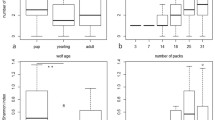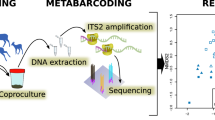Abstract
Captive management practices have the potential to drastically alter pre-existing host-parasite relationships. This can have profound implications for the health and productivity of threatened species in captivity, even in the absence of clinical symptoms of disease. Maximising the success of captive breeding programmes requires a detailed knowledge of anthropogenic influences on the structure of parasite assemblages in captive systems. In this study, we employed two high-throughput molecular techniques to characterise the parasitic nematode (suborder Strongylida) communities of the red kangaroo, Macropus rufus, across seven captive sites. The first was terminal restriction fragment length polymorphism (T-RFLP) analysis of a region of rDNA encompassing the internal transcribed spacers 1 (ITS1), the 5.8S rRNA gene and the internal transcribed spacer 2 (ITS2). The second was Illumina MiSeq next-generation sequencing of the ITS2 region. The prevalence, intensity of infection, taxonomic composition and comparative structure of strongylid nematode assemblages was assessed at each location. Prevalence (P = <0.001) and mean infection intensity (df = 6, F = 17.494, P = <0.001) differed significantly between the seven captive sites. Significant levels of parasite community structure were observed (ANOSIM, P = 0.01), with most of the variation being distributed within, rather than between, captive sites. The range of nematode taxa that occurred in captive red kangaroos appeared to differ from that of wild conspecifics, with representatives of the genus Cloacina, a dominant nematode parasite of the macropodid forestomach, being detected at only two of the seven study sites. This study also provides the first evidence for the presence of the genus Trichostrongylus in a macropodid marsupial. Our results demonstrate that contemporary species management practices may exert a profound influence on the structure of parasite communities in captive systems.


Similar content being viewed by others
References
Arneberg P, Skorping A, Grenfell B, Read AF (1998) Host densities as determinants of abundance in parasite communities. P R Soc B 265:1283–1289
Arundel JH, Beveridge I, Presidente PJ (1979) Parasites and pathological findings in enclosed and free-ranging populations of Macropus rufus (Demarest) (Marsupialia) at Menindee, New South Wales. Aust Wild Res 6:361–379
Audebert F, Hoste H, Durette-Desset MC (2002) Life cycle of Trichostrongylus retortaeformis in its natural host, the rabbit (Oryctolagus cuniculus). J Helminthol 76:189–192
Brunsdon RV (1980) Principles of helminth control. Vet Parasitol 6:185–215
Campbell AJD, Gasser RB, Chilton NB (1995) Differences in a ribosomal DNA sequence of Strongylus species allows identification of single eggs. Int J Parasitol 25:359–365
Chilton NB (2004) The use of nuclear ribosomal DNA markers for the identification of bursate nematodes (order Strongylida) and for the diagnosis of infections. Anim Health Res Rev 5:173–187
Chilton NB, Huby-Chilton F, Gasser RB (2003) First complete large subunit rRNA sequence and secondary structure for a parasitic nematode: phylogenetic and diagnostic implications. MGG 17:33–39
Culman SW, Bukowski R, Gauch HG, Cadillo-Quiroz H, Buckley DH (2009) T-REX: software for the processing and analysis of T-RFLP data. BMC Bioinf 10:171–181
Cunningham AA (1996) Disease risks of wildlife translocations. Conserv Biol 10:349–353
Dickie IA, Xu W, Koide RT (2002) Vertical niche differentiation of ectomycorrhizal hyphae in soils as shown by T-RFLP analysis. New Phytol 156:527–535
Edgar RC, Haas BJ, Clemente JC, Quince C, Knight R (2011) UCHIME improves sensitivity and speed of chimera detection. Bioinformatics 27:2194–2200
Eldridge MDB (2010) In: Coulson GM, Eldridge MDB (eds) ‘Macropods: the biology of kangaroos, wallabies and rat-kangaroos’. CSIRO Publishing, Melbourne, pp 35–51
Ferrer M, Negro JJ (2004) The near extinction of two large European predators: super specialists pay a price. Conserv Biol 18:344–349
Fèvre EM, Bronavoort BMC, Hamilton KA, Cleaveland S (2006) Animal movements and the spread of infectious diseases. Trends Microbiol 14:125–131
Gasser RB, Chilton NB, Hoste H, Beveridge I (1993) Rapid sequencing of rDNA from single worms and eggs of parasitic helminths. Nucleic Acids Res 21:2525–2526
Gómez A, Nichols E (2013) Neglected wild life: parasitic biodiversity as a conservation target. Int J Parasitol 2:222–227
Henriksen SA, Aggaard K (1976) A simple flotation and McMaster method. Nord Vet Med 28:392–397
Hoste H, Gasser RB, Chilton NB, Mallet S, Beveridge I (1993) Lack of intraspecific variation in the second internal transcribed spacer (ITS-2) of Trichostrongylus colubriformis ribosomal DNA. Int J Parasitol 23:1069–1071
Hudson PJ, Dobson AP, Lafferty KD (2006) Is a healthy ecosystem one that is rich in parasites? Trends Ecol Evol 21:381–385
Huxham M, Raffaelli D, Pike A (1995) Parasites and food web patterns. J Anim Ecol 64:168–176
Lafferty KD (2003) Is disease increasing or decreasing, and does it impact or maintain biodiversity. J Parasitol 89:101–105
Lazarevic V, Whiteson K, Huse S, Hernandez D, Farinelli L, Østerås M, Schrenzel J, François P (2009) Metagenomic study of the oral microbiota by Illumina high-throughput sequencing. J Microbiol Methods 3:266–271
Leathwick DM, Miller CM, Atkinson DS, Haack NA, Waghorn TS, Oliver AM (2008) Managing anthelmintic resistance: untreated adult ewes as a source of unselected parasites, and their role in reducing parasite populations. N Z Vet J 56:184–195
Liu W, Marsh TL, Forney L (1997) Characterisation of microbial diversity by determining terminal restriction fragment length polymorphisms of genes encoding 16S rRNA. Appl Environ Microbiol 63:4516–4522
Lively CM, Dybdahl MF, Jokela J, Osnas EE, Delph LF (2004) Host sex and local adaptation by parasites in a snail-trematode interaction. Am Nat 164:6–18
Lott MJ, Elderidge MDB, Hose GC, Power ML (2012) Nematode community structure in the brush-tailed rock-wallaby, Petrogale penicillata: implications of captive breeding and the translocation of wildlife. Exp Parasitol 132:185–192
Lott MJ, Hose GC, Power ML (2014) Towards the molecular characterisation of parasitic nematode assemblages: an evaluation of terminal-restriction fragment length polymorphism (T-RFLP) analysis. Exp Parasitol 144:76–83
Lyles AM, Dobson AP (1993) Infectious disease and intensive management: population dynamics, threatened hosts and their parasites. J Zool Wildlife Med 24:315–326
Marcogliese D (2002) Food webs and the transmission of parasites to marine fish. Parasitology 124:83–99
Metzker ML (2010) Sequencing technologies—the next generation. Nat Rev Genet 11:31–46
Mitchell CE, Power AG (2003) Release of invasive plants from fungal and viral pathogens. Nature 421:625–627
Mykytowycz R (1964) A survey of the endoparasites of the red kangaroo Megaleia rufa (Desmarest). Parasitology 54:677–693
Newton LA, Chilton NB, Beveridge I, Hoste H, Nansen P, Gasser RB (1998) Genetic markers for strongylid nematodes of livestock defined by PCR-based restriction analysis of spacer rDNA. Acta Trop 69:1–15
Nunn CL, Altizer S, Jones KE, Sechrest W (2003) Comparative tests of parasite species richness in primates. Am Nat 162:597–614
Raffel TR, Lloyd-Smith JO, Sessions SK, Hudson PJ, Rohr JR (2011) Does the early frog catch the worm? Disentangling potential drivers of a parasite age—intensity relationship in tadpoles. Oecologia 165:1031–1042
Schloss PD, Westcott SL, Ryabin T, Hall JR, Hartmann M, Hollister EB, Lesniewski RA, Oakley BB, Parks DH, Robinson CJ, Sahl JW, Stres B, Thallinger GG, Van Horn DJ, Weber CF (2009) Introducing mothur: open-source, platform-independent, community-supported software for describing and comparing microbial communities. Appl Environ Microbiol 75:7537–7541
Schmidt PA, Bálint M, Greshake B, Bandow C, Römbke J, Schmitt I (2013) Illumina metabarcoding of a soil fungal community. Soil Biol Biochem 65:128–132
Schwanz L (2008) Chronic parasitic infection alters reproductive output in deer mice. Behav Ecol Sociobiol 62:1351–1358
Stankiewicz M, McMurtry LW, Hadas E, Heath DD, Cowan PE (1996a) Trichostrongylus Colubriformis, T. vitrinus and T. retortaeformis infection in New Zealand possums. New Zeal Vet J 44:201–202
Stankiewicz M, Jowett GH, Roberts MG, Heath DD, Cowan P, Clark JM, Jowett J, Charleston JW (1996b) Internal and external parasites of possums (Trichosurus vulpecula) from forest and farmland, Wanganui, New Zealand. New Zeal J Zool 23:345–353
Stevenson LA, Chilton NB, Gasser RB (1995) Differentiation of Haemonchus placei from H. contortus (Nematoda: Trichostrongylidae) by the ribosomal DNA second internal transcribed spacer. Int J Parasitol 25:483–488
Thompson RM, Mouritsen KN, Poulin R (2005) Importance of parasites and their life cycle characteristics in determining the structure of a large marine food web. J Anim Ecol 74:77–85
Torchin ME, Lafferty KD, Kuris AM (2001) Release from parasites as natural enemies: increased performance of a globally introduced marine crab. Biol Investig 3:333–345
Turner WC, Getz WM (2010) Seasonal and demographic factors influencing gastrointestinal parasitism in ungulates of Etosha National Park. J Wildl Dis 46:1108–1119
Tymensen L, Barkley C, McAllister TA (2012) Relative diversity and community structure analysis of rumen protozoa according to T-RFLP and microscopic methods. J Microbiol Methods 88:1–6
Wang M, Ahrne S, Antonsson M, Molin G (2004) T-RFLP combined with principal component analysis and 16S rRNA gene sequencing: an effective strategy for comparison of fecal microbiota in infants of different ages. J Microbiol Methods 59:53–69
Woodford MH, Rossiter PB (1993) Disease risks associated with wildlife translocation projects. Rev Sci Tech Oie 12:115–135
Zarlenga DS, Hoberg EP, Stringfellow F, Lichtenfels JR (1998) Comparisons of two polymorphic species of Ostertagia and phylogenetic relationships within the Ostertagiinae (Nematoda: Trichostrongyloidea) inferred from ribosomal DNA repeat and mitochondrial DNA sequences. J Parasitol 84:806–812
Acknowledgments
Funding for this study was provided by Macquarie University. The funding body had no direct role in the design of the study, data analysis or the decision to publish. The authors would also like to thank Liana Anderson, Simon Brown, Jasmine Day, Caroline Lawrence, Byron Manning, David McLelland, Franciscus Scheelings and Vanessa Stebbings for their assistance in procuring red kangaroo faecal samples.
Compliance statement
Formal ethics approval was not required, as there was no contact between any of the authors and the red kangaroos from which faecal samples were sourced. However, the study reported herein was performed in full compliance with current local laws and regulations pertaining to the ethical treatment of animals.
Author information
Authors and Affiliations
Corresponding author
Rights and permissions
About this article
Cite this article
Lott, M.J., Hose, G.C. & Power, M.L. Parasitic nematode communities of the red kangaroo, Macropus rufus: richness and structuring in captive systems. Parasitol Res 114, 2925–2932 (2015). https://doi.org/10.1007/s00436-015-4494-z
Received:
Accepted:
Published:
Issue Date:
DOI: https://doi.org/10.1007/s00436-015-4494-z




